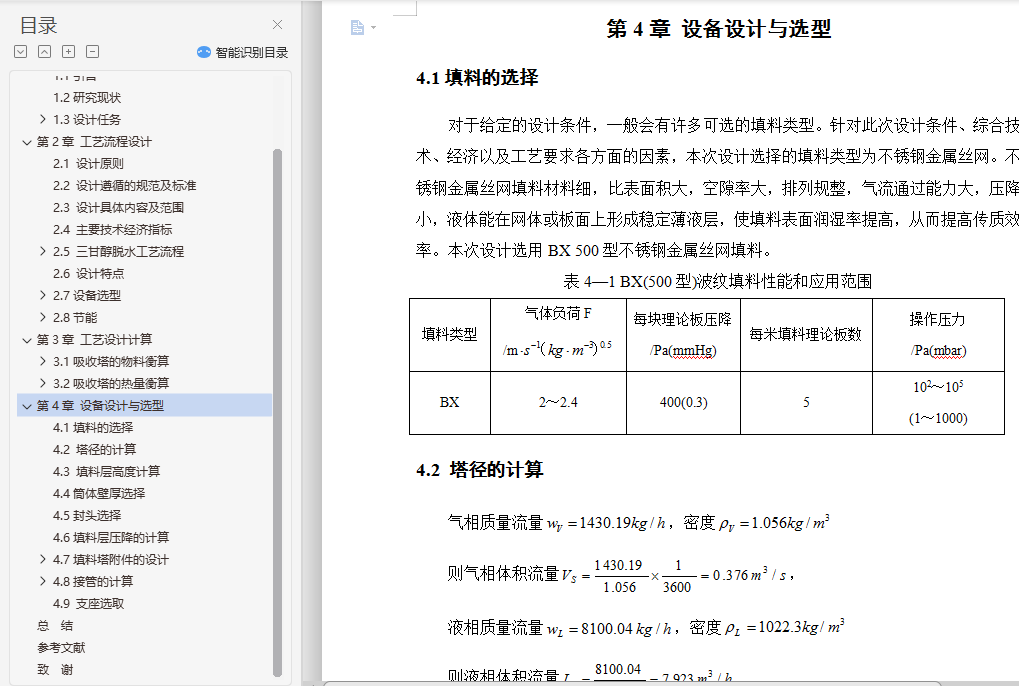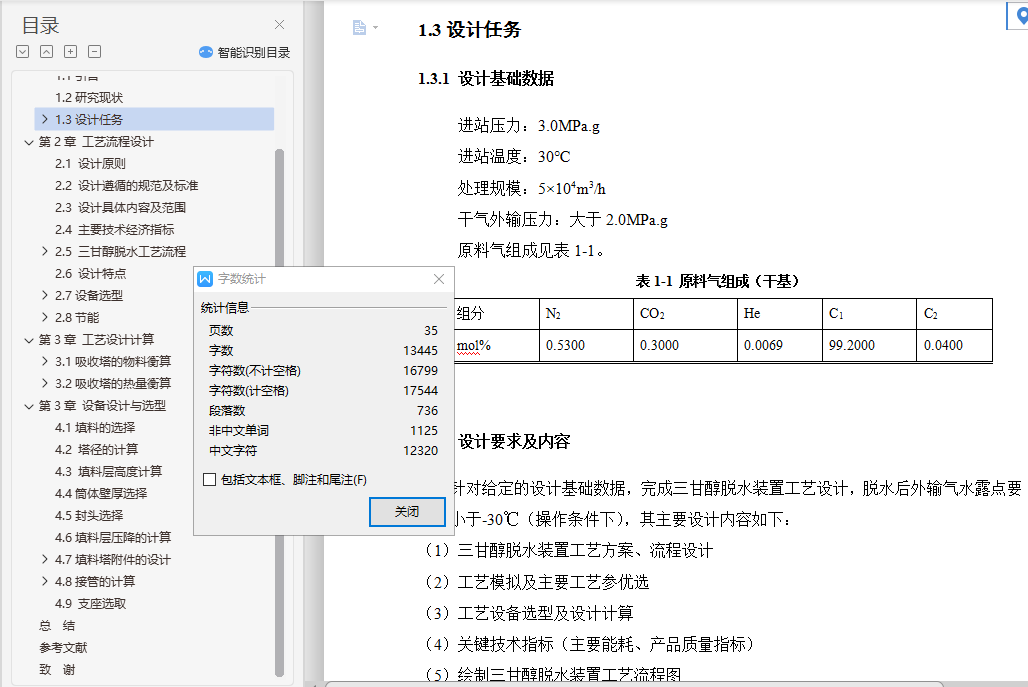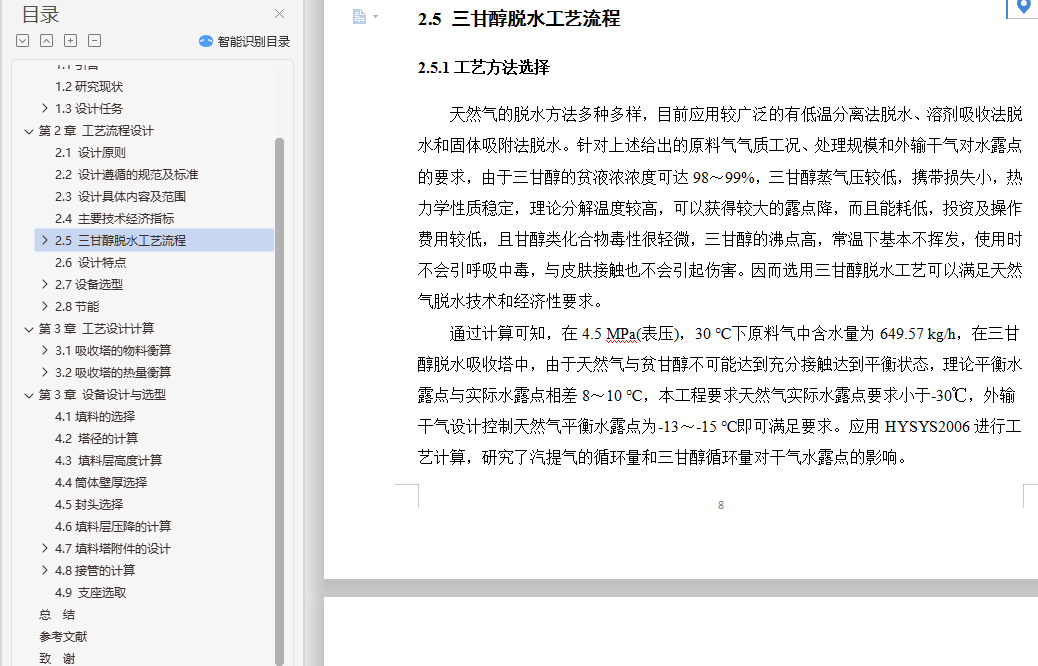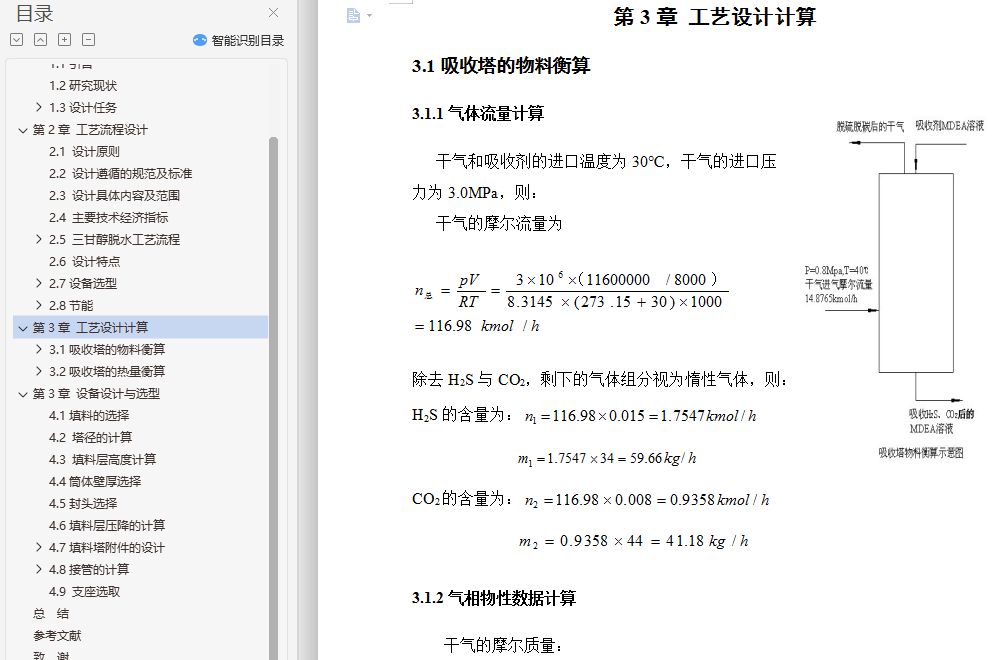5×104Nm3/h天然气三甘醇脱水工艺设计
摘要
天然气在离开油藏时或自地下储集层中采出的的天然气及脱硫后的天然气通常含有水蒸气,有些气还含有H2S和CO2,酸性气体会便管线和设备腐蚀,水蒸气在天然气的压力和温度改变时容易形成水化物,不符合天然气集输和深加工的要求,因此必须脱除天然气中的水蒸气、H2S和CO2。
在油气田中常规的天然气脱水工艺是溶剂吸收法和固体干燥剂吸附法,目前广泛使用的是甘醇吸收脱水和分子筛吸附脱水两种工艺方法。这两种方法应用的界限为要求净化后天然气中含水量的多少。也就是天然气水露点是多少。对天然气深冷分离装置要求天然气水露点必须很低,通常使用分子筛吸附脱水工艺。如果是为了保证天然气集输过程中不形成水化物,通常使用三甘醇吸收脱水工艺。
本次设计的产品气要求比输送条件下最低环境温度低5℃,此处按≤-30℃设计,计算物料、热量衡算;PFD(包括设备、物流、自动控制点);设备布置图;关键设备的装配图。
关键词:三甘醇;脱水工艺;物料;热量;衡算
Abstract
Natural gas produced when it leaves a reservoir or from an underground reservoir and after desulphurization usually contains water vapor,some of which contain H2S and CO2,acidic gases that can corrode pipelines and equipment. Water vapor is easy to form hydrate when the pressure and temperature of natural gas change,which does not meet the requirements of natural gas gathering,transportation and deep processing. Therefore,water vapor,H2S and CO2. must be removed from natural gas.
The conventional process of natural gas dehydration in oil and gas fields is solvent absorption method and solid desiccant adsorption method. At present,two kinds of process methods are widely used:ethylene glycol absorption dehydration and molecular sieve adsorption dehydration. The limits of application of the two methods are the amount of water content in the purified natural gas. That is,what is the dew point of natural gas. For cryogenic separation of natural gas,the dew point of natural gas must be very low,and molecular sieve adsorption dehydration process is usually used. The triethylene glycol absorption dehydration process is usually used to ensure that no hydrate is formed during natural gas gathering and transportation.
The product gas requirement of this design is 5 ℃ lower than the lowest ambient temperature under the condition of transportation. Here,according to the design of ≤-30 ℃,the material,heat balance;PFD (including equipment,logistics,automatic control point),equipment layout diagram,etc. Assembly drawing of key equipment.
Keywords:triethylene glycol;dehydration process;material;heat;accounting
目 录
摘要 I
Abstract II
第1章 绪论 1
1.1引言 1
1.2研究现状 2
1.3设计任务 4
1.3.1 设计基础数据 4
1.3.2 设计要求及内容 4
1.3.3 设计文档要求 5
第2章 工艺流程设计 6
2.1 设计原则 6
2.2 设计遵循的规范及标准 6
2.3 设计具体内容及范围 6
2.4 主要技术经济指标 7
2.5 三甘醇脱水工艺流程 8
2.5.1工艺方法选择 8
2.5.2三甘醇脱水工艺流程简述 9
2.6 设计特点 9
2.7设备选型 10
2.7.1 原料气过滤分离器 10
2.7.2 干气出口分离器 11
2.7.3 吸收塔 11
2.7.4 再生系统 13
2.7.5 过滤器 13
2.7.6三甘醇循环泵 15
2.8节能 15
2.8.1 系统能耗 15
2.8.2节能措施 16
第3章 工艺设计计算 17
3.1吸收塔的物料衡算 17
3.1.1气体流量计算 17
3.1.2气相物性数据计算 17
3.1.3液相物性数据计算 18
3.1.4吸收剂MEDA溶液用量的计算 18
3.2吸收塔的热量衡算 19
3.2.1设计条件 19
3.2.2热量衡算 20
第3章 设备设计与选型 22
4.1填料的选择 22
4.2 塔径的计算 22
4.3 填料层高度计算 23
4.4筒体壁厚选择 23
4.5封头选择 23
4.6填料层压降的计算 23
4.7填料塔附件的设计 24
4.7.1液体分布装置 24
4.7.2填料支承装置 24
4.7.3液体再分布装置 24
4.8接管的计算 25
4.8.1塔底气体进料口接管 25
4.8.2塔底液体出口管 25
4.8.3塔顶液体进料口管 25
4.8.4塔顶气体出口管 26
4.8.5测压测温管 26
4.8.6排污管 26
4.9 支座选取 27
总 结 28
参考文献 29
致 谢 30








